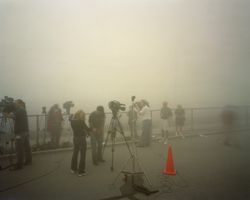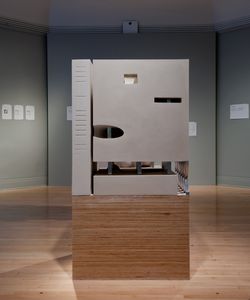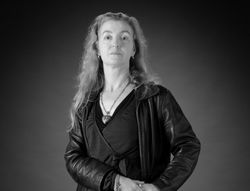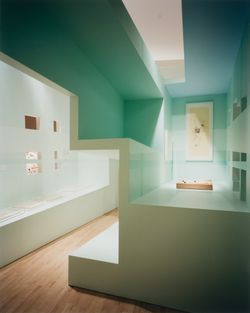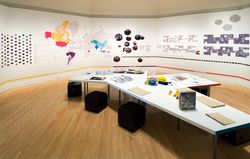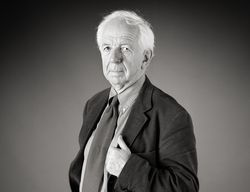Robert Burley, CCA Mellon Senior Fellow and Assistant Professor at Ryerson University, speaks on “The Architecture of Photography in an Age of Obsolescence.” The CCA Mellon Foundation Senior Fellowship Program was established in 2001 to encourage advanced research in architectural history and thought. With the generous support of The Andrew W. Mellon Foundation,(...)
Paul Desmarais Theatre
16 September 2010, 6pm
Robert Burley: The Architecture of Photography in an Age of Obsolescence
Actions:
Description:
Robert Burley, CCA Mellon Senior Fellow and Assistant Professor at Ryerson University, speaks on “The Architecture of Photography in an Age of Obsolescence.” The CCA Mellon Foundation Senior Fellowship Program was established in 2001 to encourage advanced research in architectural history and thought. With the generous support of The Andrew W. Mellon Foundation,(...)
Paul Desmarais Theatre
DR1974:0002:012:001-049
Description:
- This album contains student drawings by Hubert Rohault de Fleury executed at the École spéciale de peinture, sculpture et architecture, Paris (1798-1802), including drawings for the Grand Prix Competitions of 1800, 1801 and 1802, the Concours d'essai, the Concours d'émulation of 1800 and 1801, and other undetermined competitions. The drawings illustrate all stages of the design and competition process, ranging from preliminary sketches and esquisses to finished renderings, but do not include the renderings submitted to the Grand Prix Competitions. Drawings for the conversion of the Église de la Madeleine into a Temple de la Gloire (ca. 1806-1807) include line and wash drawings. Hubert's 1800 Grand Prix entry for an École nationale des beaux-arts was awarded the "deuxième Grand Prix" and this album includes: the esquisse; a handwritten copy of the programme; 11 large-scale line drawings - sections, elevations, and details of the ornamentation (DR1974:0002:012:008 R; DR1974:0002:012:012 R; DR1974:0002:012:037, DR1974:0002:012:039, DR1974:0002:012:041 - DR1974:0002:012:049). Two other drawings depict an École des beaux-arts, but they do not conform to the esquisse of Hubert's 1800 Grand Prix entry (DR1974:0002:012:012 V and DR1974:0002:012:013). Hubert's 1801 Grand Prix entry for a forum or public square dedicated to peace, is represented by the esquisse and four elevations, one coloured with wash (DR1974:0002:012:009 R/V - DR1974:0002:012:011 R). Studies of triumphal arches, probably relate to this project (DR1974:0002:012:011 V). Hubert's winning 1802 Grand Prix entry for a public fair with a hall for the exhibition of products of industry located on the banks of a large river is represented by an elevation and sectional elevation for the esquisse; 3 prints; finished plans, one of which is possibly part of the esquisse; elevations; sectional elevations; and one section (DR1974:0002:012:001 R/V - DR1974:0002:012:006 R/V:001-004). Three drawings which are apparently for public fairs are perhaps studies for the 1802 Grand Prix Competition (DR1974:0002:012:007 R:001-003). Also included are Hubert's entries in the Concours d'essai for each of these Grand Prix Competitions. The presence of "devises" on several drawings indicates they are the submitted competition entries: a school or college for the Concours d'émulation of 25 June 1801, for which Rohault de Fleury won a medal, a temple, a lycée, an opera house, a public bath, a sepulchral chapel, and possibly an exchange. An uncharacteristic nocturnal elevation is possibly for a cenotaph dedicated to Isaac Newton (DR1974:0002:012:014). Rohault de Fleury's design for the conversion of the Église de la Madeleine is represented by two plans (one with an elevation) drawn on engraved plans of the Madeleine, three sketch plans, a section, an elevation of a capital and other ornamentation, and an engraved plan of the designs by Pierre Contant d'Ivry and Guillaume Martin Couture for the same project.
architecture, temporary architecture, urban planning
drawings executed 1800-1807, manuscripts between 1800 and 1802, published 1806
Album of student drawings for architectural competitions held at the École spéciale de peinture, sculpture et architecture and drawings for the conversion of the Église de la Madeleine into a Temple de la Gloire, Paris
Actions:
DR1974:0002:012:001-049
Description:
- This album contains student drawings by Hubert Rohault de Fleury executed at the École spéciale de peinture, sculpture et architecture, Paris (1798-1802), including drawings for the Grand Prix Competitions of 1800, 1801 and 1802, the Concours d'essai, the Concours d'émulation of 1800 and 1801, and other undetermined competitions. The drawings illustrate all stages of the design and competition process, ranging from preliminary sketches and esquisses to finished renderings, but do not include the renderings submitted to the Grand Prix Competitions. Drawings for the conversion of the Église de la Madeleine into a Temple de la Gloire (ca. 1806-1807) include line and wash drawings. Hubert's 1800 Grand Prix entry for an École nationale des beaux-arts was awarded the "deuxième Grand Prix" and this album includes: the esquisse; a handwritten copy of the programme; 11 large-scale line drawings - sections, elevations, and details of the ornamentation (DR1974:0002:012:008 R; DR1974:0002:012:012 R; DR1974:0002:012:037, DR1974:0002:012:039, DR1974:0002:012:041 - DR1974:0002:012:049). Two other drawings depict an École des beaux-arts, but they do not conform to the esquisse of Hubert's 1800 Grand Prix entry (DR1974:0002:012:012 V and DR1974:0002:012:013). Hubert's 1801 Grand Prix entry for a forum or public square dedicated to peace, is represented by the esquisse and four elevations, one coloured with wash (DR1974:0002:012:009 R/V - DR1974:0002:012:011 R). Studies of triumphal arches, probably relate to this project (DR1974:0002:012:011 V). Hubert's winning 1802 Grand Prix entry for a public fair with a hall for the exhibition of products of industry located on the banks of a large river is represented by an elevation and sectional elevation for the esquisse; 3 prints; finished plans, one of which is possibly part of the esquisse; elevations; sectional elevations; and one section (DR1974:0002:012:001 R/V - DR1974:0002:012:006 R/V:001-004). Three drawings which are apparently for public fairs are perhaps studies for the 1802 Grand Prix Competition (DR1974:0002:012:007 R:001-003). Also included are Hubert's entries in the Concours d'essai for each of these Grand Prix Competitions. The presence of "devises" on several drawings indicates they are the submitted competition entries: a school or college for the Concours d'émulation of 25 June 1801, for which Rohault de Fleury won a medal, a temple, a lycée, an opera house, a public bath, a sepulchral chapel, and possibly an exchange. An uncharacteristic nocturnal elevation is possibly for a cenotaph dedicated to Isaac Newton (DR1974:0002:012:014). Rohault de Fleury's design for the conversion of the Église de la Madeleine is represented by two plans (one with an elevation) drawn on engraved plans of the Madeleine, three sketch plans, a section, an elevation of a capital and other ornamentation, and an engraved plan of the designs by Pierre Contant d'Ivry and Guillaume Martin Couture for the same project.
drawings, textual records, works of art
drawings executed 1800-1807, manuscripts between 1800 and 1802, published 1806
architecture, temporary architecture, urban planning
A super-library combining five national collections in one building, Paris’s National Library of France was the final Grands travaux of President François Mitterrand. Initially commissioned to house all French production of words, images, and sounds since 1945, its architectural competition captured the confusion and variety of architectural thinking in 1989. OMA’s(...)
Octagonal gallery
15 May 2012 to 9 September 2012
Très Grande Bibliothèque (Very Big Library)
Actions:
Description:
A super-library combining five national collections in one building, Paris’s National Library of France was the final Grands travaux of President François Mitterrand. Initially commissioned to house all French production of words, images, and sounds since 1945, its architectural competition captured the confusion and variety of architectural thinking in 1989. OMA’s(...)
Octagonal gallery
At the beginning of powered flight, most airplanes required only a stretch of grassy plain 1,500 feet long for take-off and landing, and a converted barn served as both terminal and hangar. Only with the advent of a profitable commercial aviation industry in the late 1920s, some twenty-five years after Wilbur and Orville Wright’s historic flight, did the modern airport(...)
Hall cases
12 June 1990 to 16 September 1990
Airport Origins: Three Projects by Lloyd Wright
Actions:
Description:
At the beginning of powered flight, most airplanes required only a stretch of grassy plain 1,500 feet long for take-off and landing, and a converted barn served as both terminal and hangar. Only with the advent of a profitable commercial aviation industry in the late 1920s, some twenty-five years after Wilbur and Orville Wright’s historic flight, did the modern airport(...)
Hall cases
Rebecca Solnit, 2008 CCA Mellon Senior Fellow, is an independent writer, historian, and activist with a particular interest in geography, landscape, slowness, insurrection, photography, indirect routes and subjects that escape category. She lives in San Francisco, has received various awards, including the Lannan, a Guggenheim, and the Western Writers of America Spur(...)
9 October 2008
Rebecca Solnit: The Ruins of Hope, Hope in the Ruins
Actions:
Description:
Rebecca Solnit, 2008 CCA Mellon Senior Fellow, is an independent writer, historian, and activist with a particular interest in geography, landscape, slowness, insurrection, photography, indirect routes and subjects that escape category. She lives in San Francisco, has received various awards, including the Lannan, a Guggenheim, and the Western Writers of America Spur(...)
*Cities of Artificial Excavation: The Work of Peter Eisenman, 1978–1988* explores how American architect and writer Peter Eisenman questioned the concept of “site,” and demonstrates the importance of drawing and modelmaking in generating his ideas. The exhibition reveals the richness and complexity of the design process by looking carefully at Eisenman’s drawings and(...)
Main galleries
2 March 1994 to 19 June 1994
Cities of Artificial Excavation: The Work of Peter Eisenman, 1978-1988
Actions:
Description:
*Cities of Artificial Excavation: The Work of Peter Eisenman, 1978–1988* explores how American architect and writer Peter Eisenman questioned the concept of “site,” and demonstrates the importance of drawing and modelmaking in generating his ideas. The exhibition reveals the richness and complexity of the design process by looking carefully at Eisenman’s drawings and(...)
Main galleries
Sub-series
Education
CI001.S2.D1
Description:
Like his father Hubert, Charles Rohault de Fleury also studied at the École polytechnique with Jean-Nicolas-Louis Durand (1820-1821), and at the École des Beaux-Arts (1823-1825), Charles studied under his father and Louis Hippolyte Lebas. The CCA collection contains his printed exercise book from the École polytechnique and an album of drawings of the orders executed at both schools. The printed exercise book (DR1974:0002:001:001-105), primarily dated to 1821, provides an overview of the first year curriculum at the École polytechnique reflecting the emphasis placed on the course in descriptive geometry. The exercises proceed from the simple to the complex; from the analysis of simple shapes to the interpretation of basic architectural elements. Many of the problems have been solved by Charles, and carry the approval seal of his professor. A large engraving included in the album provides a succinct table recording the career paths of graduating students in the various Écoles d'application, a description of the core curriculum, and a historical and chronological outline of the École polytechnique from its inception to 1828. Charles' studies of the architectural orders (DR1974:0002:019:001-033), many of which are copied directly from Charles Normand's 'Nouveau parallele des ordres d'architecture...,' demonstrate the continued application of Durand's methodology applied to typical Beaux-Arts studies. The orders executed at the École polytechnique are pared down to their essential form and porticos are abstracted and grouped according to their tetrastyle, hexastyle, or octastyle configurations, whereas the orders completed at the École des beaux-arts are simplified, but still reflect the traditional mimetic interpretation of classical antiquity, with its fidelity to mouldings and details. The conspicous abscence of the composite order and the addition of the 'Dorique Romain and Moderne', attest to the continued influence of Durand's ''Precis'. The information regarding George's architectural career is limited to twelve drawings for architectural ornament and sculpture (1858-1859) submitted to a newly introduced, and obligatory, 'dessin' Concours d'emulation at the École des beaux-arts (1). (1) R. Chaffe, "The teaching of architecture at the École des Beaux-Arts" in Arthur Drexler ed., 'The Architecture of the École des Beaux-Arts' (New York: MOMA, 1975), p.84 and fn. 120.)
[1776?]-1868
Education
CI001.S2.D1
Description:
Like his father Hubert, Charles Rohault de Fleury also studied at the École polytechnique with Jean-Nicolas-Louis Durand (1820-1821), and at the École des Beaux-Arts (1823-1825), Charles studied under his father and Louis Hippolyte Lebas. The CCA collection contains his printed exercise book from the École polytechnique and an album of drawings of the orders executed at both schools. The printed exercise book (DR1974:0002:001:001-105), primarily dated to 1821, provides an overview of the first year curriculum at the École polytechnique reflecting the emphasis placed on the course in descriptive geometry. The exercises proceed from the simple to the complex; from the analysis of simple shapes to the interpretation of basic architectural elements. Many of the problems have been solved by Charles, and carry the approval seal of his professor. A large engraving included in the album provides a succinct table recording the career paths of graduating students in the various Écoles d'application, a description of the core curriculum, and a historical and chronological outline of the École polytechnique from its inception to 1828. Charles' studies of the architectural orders (DR1974:0002:019:001-033), many of which are copied directly from Charles Normand's 'Nouveau parallele des ordres d'architecture...,' demonstrate the continued application of Durand's methodology applied to typical Beaux-Arts studies. The orders executed at the École polytechnique are pared down to their essential form and porticos are abstracted and grouped according to their tetrastyle, hexastyle, or octastyle configurations, whereas the orders completed at the École des beaux-arts are simplified, but still reflect the traditional mimetic interpretation of classical antiquity, with its fidelity to mouldings and details. The conspicous abscence of the composite order and the addition of the 'Dorique Romain and Moderne', attest to the continued influence of Durand's ''Precis'. The information regarding George's architectural career is limited to twelve drawings for architectural ornament and sculpture (1858-1859) submitted to a newly introduced, and obligatory, 'dessin' Concours d'emulation at the École des beaux-arts (1). (1) R. Chaffe, "The teaching of architecture at the École des Beaux-Arts" in Arthur Drexler ed., 'The Architecture of the École des Beaux-Arts' (New York: MOMA, 1975), p.84 and fn. 120.)
File 1
[1776?]-1868
Inside the Sponge
Simmons Hall is an award-winning university dormitory designed by architect Steven Holl on the Massachusetts Institute of Technology (MIT) campus in Cambridge. Inspired by the sea sponge and the concept of porosity, the building is radical in structure and ambitious in its program to encourage social interaction. Inside the Sponge is an investigation of Simmons Hall from(...)
Octagonal gallery
10 August 2006 to 19 November 2006
Inside the Sponge
Actions:
Description:
Simmons Hall is an award-winning university dormitory designed by architect Steven Holl on the Massachusetts Institute of Technology (MIT) campus in Cambridge. Inspired by the sea sponge and the concept of porosity, the building is radical in structure and ambitious in its program to encourage social interaction. Inside the Sponge is an investigation of Simmons Hall from(...)
Octagonal gallery
archives
Level of archival description:
Fonds
Roger D’Astous fonds
AP060
Synopsis:
Le fonds témoigne des activités personnelles et professionnelles de Roger D'Astous, de sa carrière d'architecte et de sa contribution à l'architecture québécoise. Il nous renseigne sur sa formation académique à l'École des Beaux-Arts de Montréal, sur son séjour en tant qu'apprenti à l'atelier de Frank Lloyd Wright à Taliesin (Arizona et Wisconsin), ainsi que sur sa pratique professionnelle en tant qu'architecte. Ces projets professionnels sont principalement concentrés au Québec, à Montréal, en Montérégie, dans les Laurentides, à Laval, ainsi qu'en Ontario (dont à Brockville et à Kingston). Le fonds contient, entre autres, 4 100 dessins d’architecture, 2 581 documents photographiques, 7 maquettes et 1,23 m.l. de documents textuels.
1893-1998, surtout 1951-1998
Roger D’Astous fonds
Actions:
AP060
Synopsis:
Le fonds témoigne des activités personnelles et professionnelles de Roger D'Astous, de sa carrière d'architecte et de sa contribution à l'architecture québécoise. Il nous renseigne sur sa formation académique à l'École des Beaux-Arts de Montréal, sur son séjour en tant qu'apprenti à l'atelier de Frank Lloyd Wright à Taliesin (Arizona et Wisconsin), ainsi que sur sa pratique professionnelle en tant qu'architecte. Ces projets professionnels sont principalement concentrés au Québec, à Montréal, en Montérégie, dans les Laurentides, à Laval, ainsi qu'en Ontario (dont à Brockville et à Kingston). Le fonds contient, entre autres, 4 100 dessins d’architecture, 2 581 documents photographiques, 7 maquettes et 1,23 m.l. de documents textuels.
archives
Level of archival description:
Fonds
1893-1998, surtout 1951-1998
Hubert Damisch, 2003-2004 CCA Mellon Senior Fellow, examines Blur – the cloud building created by New York architects Diller + Scofidio on lake Neuchâtel in Switzerland, which is the most recent and radical expression of the desire for fluidity and evanescence in architecture – and the consequences that it might have on the future of structural thought. Damisch examines(...)
Paul Desmarais Theatre
8 May 2003
Hubert Damisch: “Effacer l’architecture?”
Actions:
Description:
Hubert Damisch, 2003-2004 CCA Mellon Senior Fellow, examines Blur – the cloud building created by New York architects Diller + Scofidio on lake Neuchâtel in Switzerland, which is the most recent and radical expression of the desire for fluidity and evanescence in architecture – and the consequences that it might have on the future of structural thought. Damisch examines(...)
Paul Desmarais Theatre
